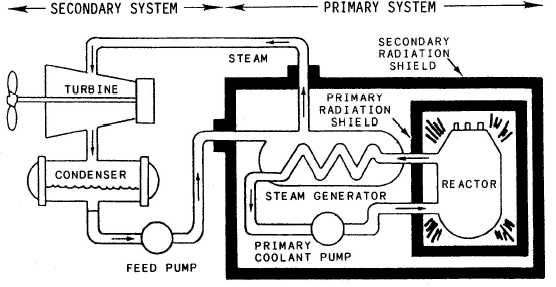| |
loop) generate steam. Water in the primary loop (fig.
17-4) is heated but not converted to steam. The water
in the primary loop flows from the reactor to a heat
exchanger called the steam generator. Here, the
high-temperature, high-- pressure water in the
primary loop heats the water in the secondary loop
until it becomes steam. The water in the primary loop
then returns to the react or by the primary coolant
pump. The steam generated in the secondary loop,
which is not superheated, goes to the turbine. This
portion of the secondary loop uses a condenser and a
feed pump similar to the conventional steam turbine
plant.
The nuclear power plant has two primary ad-
vantages— infrequent fueling requirements and no
need for combustion air. The ability of the plant to
operate without combustion air, as previously
mentioned, makes it ideal for use in submarines. The
nuclear power plant is, however, expensive to build
and extremely heavy; it requires highly trained
personnel for its operation.
DAMAGE CONTROL
An area of engineering that should by no
means be considered secondary is damage control
(DC). Damage control is an all-hands evolution on
Navy ships that can never be overemphasized.
DAMAGE CONTROL ORGANIZATION
Damage control is divided into two phases-
administrative and battle. The administrative phase
requires
the
efforts
of
all
hands
in
establishing
and
maintaining
material
readiness
conditions.
(Material
readiness
means all equipment aboard ship is available
and in a working condition to combat any
emergency.) The battle phase starts after a
ship has received damage and must restore its
offensive and defensive capabilities. All hands
must be trained in both phases if the ship is to
achieve its damage control objectives.
When properly carried out, the first or
initial action taken helps reduce and confine any
damage received. Strict use of compartment
checkoff lists ensures the full protection offered
by each material readiness condition.
Once the ship has been damaged, the
ship’s DC organization is responsible for
restoring the ship to as near normal operation as
possible.
The
ship’s
engineer
officer
is
responsible for the operational readiness of the
DC organization. Under the engineer officer the
damage control assistant (DCA) coordinates the
efforts of repair parties in the control of damage.
These efforts include controlling the ship’s
stability; fighting fires; repairing damage; and
using chemical, biological, and radiological
(CBR) defense measures. The DCA also ensures
that the crew receives training in all damage
control evolutions. In some instances, the DCA
and the engineer officer may be the same
person.
Figure 17-4.—Naval nuclear power propulsion plant.
17-9
|

